
At the Chef’s Counter at o ya
In most cities, there are a select few restaurants that hardly ever seem to receive any negative press from public and critics alike—Fore Street in Portland, Alinea in Chicago, and o ya in Boston are three examples that come to mind. For me, the experience of dining at these restaurants involves the added theme of wondering how they are able to elicit such mass appeal—what do these restaurants do to engineer this reception? It would appear that o ya is possibly the most decorated restaurant in Boston; chef/owner Tim Cushman won the Best Chef Northeast James Beard Award for 2012, and after opening in 2007, Frank Bruni famously called it the best new restaurant in America. Evaluating o ya was to be difficult since I have almost no experience with sushi restaurants. In fact, the only other omakase experience I’d had was at Miyake in Maine. Still, I was obviously aware of the strong acclaim and made a reservation for the chef’s counter on a recent Saturday evening.
One potential challenge facing o ya is its location; located in the leather district (near Chinatown), the setting would appear antithetical for a fine dining restaurant. As a believer that restaurants should take a synthetic approach to décor that acknowledges the building’s history and the surrounding neighborhood, I was curious to see how the restaurant would avoid simply imposing itself on a landscape that didn’t accommodate it, a problem I found with Acadia in Chicago. Interestingly, o ya solves this issue through maintaining an exterior that is as nondescript as possible—there really isn’t a clear façade to the space. Similar to Alinea, this has the effect of making the space feel exclusive without being too fancy for the environs.
The unusual interior combines traditional Japanese stylings with modernity; one wall features horizontal sliding windows and a geometric pattern that seemed borrowed from an Ozu film. Meanwhile, this highly traditional Japanese motif contrasts with the music, which spanned hard rock, jazz, and even campy songs such as the “Trolley Song” from Meet Me in St. Louis. The dining room is also structured in an unusual way; even though one enters it vertically, the space is horizontally organized. With two rows of seats—a bar and a single row of two-tops—it is arranged analogously to a classroom with two rows of desks. While very condensed, the cramped feel is difficult to avoid when there are only 37 seats. Having noted the spatial limitations, the room manages to be handsome in a grungy way, with ample amounts of exposed brick. It is also exceptionally dark, which organically creates a decent amount of drama but made me grateful for the track lighting, without which taking pictures would have been impossible.
Online reservations at o ya are only available at the chef’s counter, though I was grateful for this since it gave me a prime view of the chefs’ virtuoso technique. I don’t usually enjoy counter-style seating since the space is not as well-demarcated, but the visual attraction was engaging enough that this wasn’t a problem.
As with most sushi restaurants, the menu at o ya is immense. Also, while I understand that I am more interested in menu font than most, in this case I think it held some significance. The title was written in an elongated, ornamental pattern, while the rest of the menu was in comic sans. I am probably making something out of nothing, but in the context of a Japanese restaurant, the fonts resonated as a cultural cliché reflecting a veiled Orientalism. Writing style aside, the menu was impressive in its girth; there were two pages of a la carte options, as well as two omakase options. The regular omakase involved 17 courses, while the grand omakase featured 20 and used more luxury ingredients. I selected the grand omakase, and also upgraded from the Kagoshima wagyu to the pure kobe beef. In fact, the main impetus for dining at o ya was that they are to my knowledge the only New England restaurant offering pure kobe beef. Considering this, it might seem surprising that I would choose a menu involving 20 courses and that didn’t serve the wagyu until the end. However, I still had to construct a meal and figured that the rest of the courses would be satisfying enough in their own right. Still, this dinner raised the issue of how to approach a long meal in which one’s enthusiasm is concentrated predominantly on a single dish.
The meal got started with a kumamoto oyster topped with watermelon pearls and cucumber mignonette. The sweetness of the watermelon nullified the brininess of the oyster, but this was still a refreshing opener.

Next came a succession of nigiri courses, beginning with hamachi and spicy banana pepper mousse—tasty but the heat of the pepper was a bit of a shock following the oyster.

A structural inefficiency surfaced immediately involving the delivery system. For some reason, the cooks in front of me did not deliver the dishes themselves, and the waitstaff was instead tasked with this duty. After retrieving the plates at the counter, they then walked back to the kitchen to determine where to deliver the dishes. As a result, I would see my plate in front of me on the counter, only to have a server take it to the kitchen and then deliver it back to me. I try to be tolerant of different serving methodologies, but the logistics were so bizarre that I can’t understand the thought process that went into this system.
Second was kinme dai with ume, Japanese plum vinaigrette, and shiso.

Third was Kamasu wild Japanese barracuda, served with yuzu, white truffle oil, and shiso. It was also quite good, although I couldn’t taste the white truffle oil. This issue surfaced throughout the meal, and it irks me when restaurants serve high-end ingredients but in paltry quantities that don’t allow one to receive their full impact.
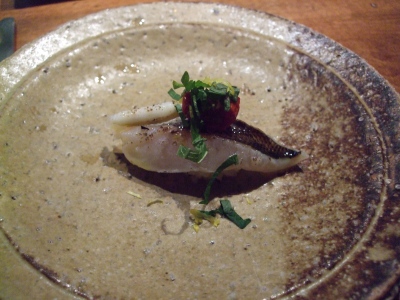
Next was wild bluefin chutoro, served with republic of Georgia herb sauce. I forgot to take a picture of it but it was nice
The meal progressed to some of o ya’s signature items. First among these was Santa Barbara sea urchin and California white sturgeon caviar, served over rice. As one would expect, the creamy brininess of the urchin went great with the caviar.

The seventh course was another o ya signature: fried kumamoto oyster with yuzu kosho aioli and squid ink bubbles. This was a very eclectic combination that worked great, although much heavier than the earlier oyster course. It was unusual to receive the same protein (oyster) twice in the meal, though I appreciated the opportunity to compare this warm oyster with the cold one that opened the meal. I wish that more restaurants would serve the same ingredient (with different preparations) twice in the same menu, as it shows off the creativity of the kitchen and versatility of the ingredient.

Moving away from the nigiri courses, the next course was Tasmanian ocean trout with smoked ikura and wasabi vinaigrette. On its own merits, this course was quite stunning, although after the heaviness of the fried oyster this would have been better served earlier in the meal. Instead of serving it after the cooked oyster, I would have placed this after the raw one. This course was also another example of the flashy serviceware used at o ya. With every course there was clear intentionality to the serving vessels, and o ya is the rare restaurant where its plating aesthetic must not only include the compositions themselves but also the plates on which they are served.
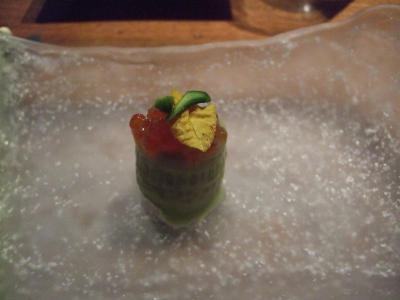
The next dish would have ordinarily been a scallop dish, but with my allergy I was instead served salmon tartare with cucumber yogurt coulis, argon oil, dill, and California white sturgeon caviar. The salmon and caviar were great, but the sauce was terrific as well.
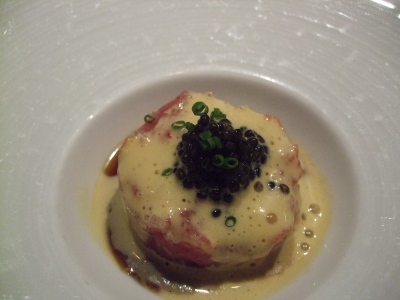
Course 10 was another o ya trademark: foe gras with miso and shaved preserved California yuzu on top. The miso rested below the foie gras and all of the components were well-harmonized. Still, this dish would likely polarize someone expecting a traditional omakase—not only did it involve foie gras, but a heavy dose of molecular gastronomy as well. Instead of following a classic omakase progression, this dish felt like something of an island in the tasting progression. To this end, it raised the issue of whether a course is worthwhile if it makes a great impact but disrupts the established rhythm—I always place a good deal of importance on the narrative of the meal, and in that regard this course was disorienting. While it may have muddled the progression of the meal, I still feel as though the incoherence was not a problem since the dish made such a strong impact.

Next was garlic shrimp with tarragon and white truffle oil. Again, the white truffle oil was indiscernible; whether this was a result of the strong effects of the garlic or they simply didn’t use enough is irrelevant—if an ingredient cannot be identified, it shouldn’t be listed in the description.

I next received wild bluefin toro, served with wasabi oil and lots of green onion. I watched the chef in front of me prepare this more than any other dish, and the toro was quite luxurious. My feelings toward the wasabi oil are less enthusiastic and the heavy dose was a bit intense for me.
 Course 13 was kanpachi, served with jalapeno sauce, sesame, apple, and myoga. Everything worked quite nicely.
Course 13 was kanpachi, served with jalapeno sauce, sesame, apple, and myoga. Everything worked quite nicely.
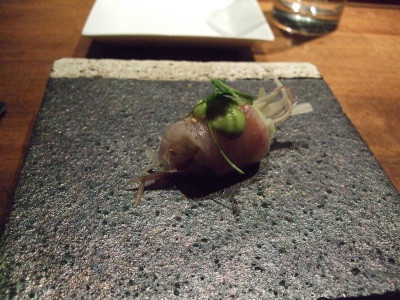
The next dish was yuzu cured artic char, smoked sesame brittle, cumin aioli, and cilantro. It was served with a lid that was then uncovered to release a hickory scent. This course was another example of the kitchen deviating from the progression (in a good way); not only was this the only cured meat course, but the serving theatrics also added some drama.
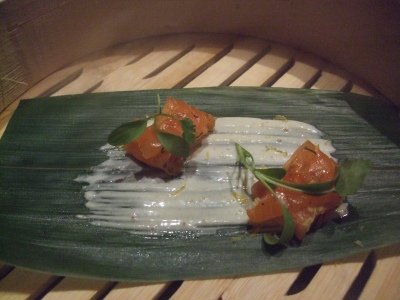
The last of the seafood courses was butter poached lobster, accompanied by shaved Perigord truffles, bonito, and a ponzu butter fondue. The lobster/black truffle combo is always a pleaser, although I would have liked to see more truffles. I also don’t understand why they called the ponzu butter sauce a fondue—it seems as though more and more restaurants are unjustifiably including “fondue” (and “flan”) in their menu descriptions, perhaps attempting to capitalize on the novelty of using a foreign term.

The next dish would be my third caviar course: “Faberge” onsen egg with white sturgeon caviar, gold leaf, dashi sauce, and green onion. I think this composition was predicated more on simply overwhelming the diner more than building on the previous courses, and it didn’t intuitively build on the lobster. However, as with the foie gras, it made an immense impact and the execution was exceptional. Conceptually, I love how this played with the egg/caviar combination, and the heavier sauce made it an appropriate fit for the latter half of the meal.

The only vegetable course followed next: grilled king oyster and shitake mushroom sashimi, with rosemary garlic oil, sesame froth, and soy. As a mushroom enthusiast, I appreciated the contrast between the grilled and sashimi mushrooms—another of my favorite dishes for the meal.

The only meat course was the kobe; it was served with confit potato and white truffle oil. The steak itself was seasoned simply with Maine sea salt. I had been expecting to receive the beef at a rare temperature and found it slightly overcooked. Obviously, the meat itself was quite fatty to begin with, but I would have appreciated an even softer mouthfeel. As it was, the steak was still delicious, but with such a high price tag I think I was more sensitive than I’d usually be with regard to the temperature.
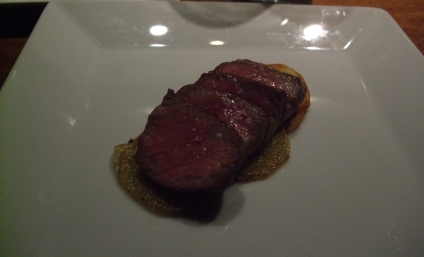
Another example of o ya’s creative serviceware, the penultimate course was a wedge of Delice de Bourgogne cheese. There was some disguise at work here, as they marinated it in miso, which cut through the creaminess of the cheese and resulted in an alarmingly strong flavor. For someone who usually finds Delice de Bourgogne a bit heavy, I really enjoyed this preparation.
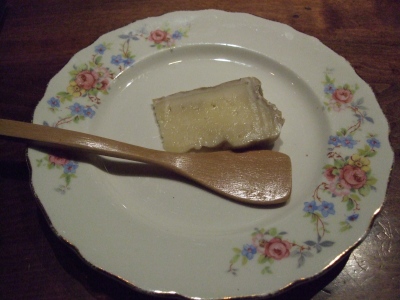 The omakase ended with foie gras nigiri, served with balsamic chocolate kabayaki, Claudio corallo raisin cocoa pulp, and a shot of 8-year aged Japanese sake. For all of my critiques about the somewhat awkward course progression, placing the foie gras nigiri as the last course was bold and a perfect fit. I don’t ordinarily like warm foie gras as much as cold preparations, but this late in the meal the sweetness of the liver worked great. I was surprised when the aged sake tasted like dessert liquor—apparently, the aging process really sweetens it, because it tasted uncannily like sherry.
The omakase ended with foie gras nigiri, served with balsamic chocolate kabayaki, Claudio corallo raisin cocoa pulp, and a shot of 8-year aged Japanese sake. For all of my critiques about the somewhat awkward course progression, placing the foie gras nigiri as the last course was bold and a perfect fit. I don’t ordinarily like warm foie gras as much as cold preparations, but this late in the meal the sweetness of the liver worked great. I was surprised when the aged sake tasted like dessert liquor—apparently, the aging process really sweetens it, because it tasted uncannily like sherry.
 In retrospect, the foie gras would have made an appropriate end to the meal, but my server offered a dessert menu. There really weren’t any interesting options, but I chose the warm chocolate pudding cake with banana tempura and goma gelato, mostly because I wanted to try the sesame gelato. What I received was basically an injustice to the kitchen—the cake itself tasted straight out of a brownie mix, and while the gelato was fine, none of the components really went together well. It is clear that a great deal of thought went into placing the foie gras dish last, and so if they want that to be the final taste of the evening, I’m not sure why they offer a dessert menu in the first place.
In retrospect, the foie gras would have made an appropriate end to the meal, but my server offered a dessert menu. There really weren’t any interesting options, but I chose the warm chocolate pudding cake with banana tempura and goma gelato, mostly because I wanted to try the sesame gelato. What I received was basically an injustice to the kitchen—the cake itself tasted straight out of a brownie mix, and while the gelato was fine, none of the components really went together well. It is clear that a great deal of thought went into placing the foie gras dish last, and so if they want that to be the final taste of the evening, I’m not sure why they offer a dessert menu in the first place.

Considering that the main reason I went to o ya was for the kobe (which fell short of expectations), it would be easy to call the meal a disappointment. This was not the case, however; a number of dishes, including the egg/caviar, mushroom, fried oyster, and dehydrated foie gras, were among the most delicious items I’ve ever tasted. Even though the hyperbolically priced meal cost 1.5 times as much as Alinea, I remain quite satisfied with the experience. Each dish felt like an event unto itself, and I think Chef Cushman is more concerned with crafting exceptional dishes than weaving them into a lucid omakase presentation. I get the sense that Chef Cushman treats his kitchen as a sort of atelier, and the free-flowing, extended menu is more of an amalgamation of his greatest hits than a carefully-devised progression.
I think it’s also worth noting that years ago Chef Cushman worked for Lettuce Entertain You, the restaurant group in Chicago. One might think that the ostentatious personality of LEY would clash with the more minimalist compositions of a sushi restaurant. However, I think the over-the-top dishes from this meal—three caviar courses, two foie gras dishes, and a black truffle course—can perhaps be attributed to Cushman’s history with LEY. Additionally, I was surprised by how Cushman’s cuisine is really sauce-based (the salmon, lobster, mushroom, and egg dishes constituting the best examples); most everything had a sauce (or foam) of some sort. Integrating so many sauces into an omakase framework is not only one of the defining aspects of Cushman’s style but may also result from his time with the Chicago restaurant group.
As a sushi neophyte, I do wonder whether I am more accepting of the eccentric ingredients and course sequence than someone expecting a traditional omakase. Instead of a flowing rhythm, the meal followed more of a start-and-stop rhythm that was unconventional but made each course more dramatic. Similar to Alinea, o ya capitalizes on the benefit of surprising the diner; in most tasting meals, the diner is lulled into a predictable rhythm early in the meal, and even if they can’t predict what will be served from one course to the next, they are not usually shocked. In contrast, o ya conditions a dynamic in which one not only cannot predict the ingredients that will be served but also has no idea which texture the ingredients will be served in or the serving vessel used. This surprise was affective and thrilling, but also made this one of the most exhausting meals I’ve experienced. Considering the ample risk taken by the kitchen, I am a bit surprised that o ya doesn’t seem to alienate more people. I think the restaurant engineers a positive response through innervating the diner with aesthetic, olfactory, and taste overload. Ultimately, I think people enjoy feeling overwhelmed when they go out to eat, and o ya makes such a strong impact that it would be hard to leave unsatisfied.
